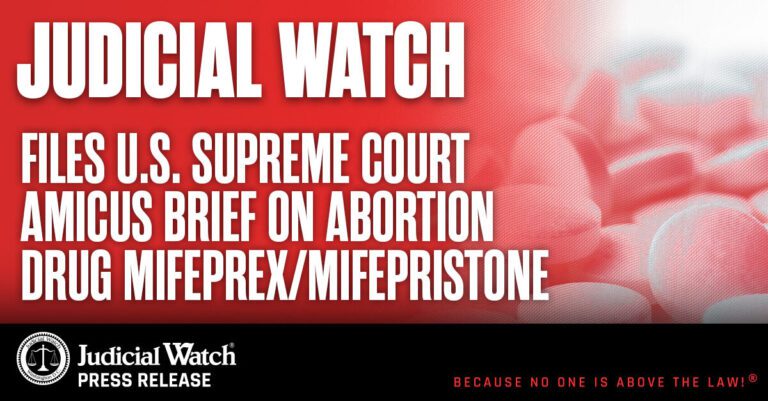
Judicial Watch Files U.S. Supreme Court Amicus Brief on Abortion Drug Mifeprex/Mifepristone

(Washington, DC) – Judicial Watch announced today that it filed an amicus (friend of the court) brief in the U.S. Supreme Court regarding the abortion drug Mifeprex (Mifepristone, formerly known as RU-486).
Judicial Watch argues “the FDA violated its own unambiguous regulation:”
The judiciary’s default position of bestowing undue deference on federal agencies has led to the rise of an unelected fourth branch of government that touches every aspect of our lives. These federal agencies wield budgets in the hundreds of billions of dollars with little to no oversight….
In 2000, the FDA harnessed the executive power from a political administration with a personal agenda bent on approving the drug mifepristone (“Mifeprex”), which intentionally ends the life of a prenatal human. In approving Mifeprex, the FDA violated its own unambiguous regulation and relied on pretext…. The FDA’s actions in 2016 and 2021 were arbitrary and capricious and violated the Administrative Procedures Act (“APA”).
***
[T]he FDA significantly revised the Mifeprex labeling and REMS [risk evaluation and mitigation strategy] in 2016 and reduced the safety requirements. These changes included significantly altered dosage, removal of the follow-up medical visit, removal of the requirement to take the drug in a doctor’s office, and expansion of the use through 70 days gestation. Also of significance and concern, the FDA modified the REMS to require reporting of only deaths attributable to the drug. No longer would hospitalizations, transfusions, or other serious adverse events need to be reported.
The FDA’s asserted rationalization for these significant changes was that it was “following the science.” The FDA has not, however, provided the science it followed that could reasonably explain the changes.
***
In 2021, using the COVID-19 pandemic as a tool, abortion proponents, led by the American College of Obstetricians and Gynecologists (“ACOG”), sued the FDA to dispense with the REMS in-person medical visit as a prerequisite for obtaining Mifeprex and permit the drug to be mailed.
Through a Freedom of Information Act (FOIA) lawsuit Judicial Watch recently uncovered at least six Mifeprex-related deaths between 2000 to 2002 that were detailed in Health and Human Services records.
“Make no mistake, this is a dangerous drug. We have known since its inception that the abortion drug Mifeprex is potentially dangerous to the mothers as well as the intended victims, the unborn babies,” said Judicial Watch President Tom Fitton. “Extremist abortion politics in the Clinton, Obama and now Biden administration are putting pregnant mothers at risk. Let’s hope the Supreme Court recognizes that an extremist abortion agenda has overcome the rule of law at the FDA.”
(The Supreme Court heard oral arguments on the abortion pill controversy today.)
Records produced to Judicial Watch in September 2023 also included an “Annual Report for Mifepristone,” covering the period September 28, 2000, to September 27, 2001, produced by the Population Council/Danco Laboratories, LLC. The summary indicated that during the testing period 32 “adverse events were reported to Danco and reported by Danco to FDA in periodic reports.” (The existence of adverse event reports does not necessarily establish causation.)
Of the 32 reported adverse events, two were 15-day reports (the others were not serious and/or not unexpected). One of the 15-day reports was reported as “hemorrhage due to a ruptured ectopic pregnancy and death.” [Emphasis added] The other was reported as “post abortal parametritis/endometritis, adult respiratory distress syndrome and bilateral pneumonia.” This latter 15-day report and one case where fever was reported represent the total reports on the marketed drug suggesting infection. In addition, one infection was reported in the Population Council’s 200 mifepristone study and one death [Emphasis added] due to clostridium sordelli infection was reported in the Canadian study.
A post-marketing study dated September 28, 2001, titled “Comparison of abortions induced by mifepristone followed by vaginal versus oral misoprostol up to 56 days gestation,” reported on the “safety results” for 940 women. One person required a blood transfusion, two required administration of intravenous fluids, one required hospitalization, and one died. [Emphasis added] The study reported an overall “success” rate of 97.8 percent.
A September 27, 2002, report on mifepristone indicated that in a study of 971 women administered a combination of mifepristone and misoprostol to induce abortions, one subject needed a blood transfusion, two were administered IV fluids, one was hospitalized, and one died. [Emphasis added]
In an April 19, 2002, “Dear Health Care Provider” letter from Danco Laboratories, in a section titled “New Safety Information,” the company noted:
We have received a small number of reports of ruptured ectopic pregnancies (including one death [Emphasis added] from hemorrhage due to a ruptured ectopic pregnancy). As you will recall, Mifeprex* and misoprostol are not an effective treatment of ectopic pregnancy. Confirmed or suspected ectopic pregnancy is a contraindication for the use of Mifeprex and should be ruled out prior to initiating Mifeprex treatment. Because ectopic pregnancy may be present despite your best efforts to rule it out before starting Mifeprex treatment, you should be mindful of the possibility of an ectopic pregnancy throughout the treatment period and have a plan for its management.
***
Two cases of serious systemic bacterial infection (one fatal) [Emphasis added] following treatment with Mifeprex and misoprostol have been reported.
***
We have also received a report of a myocardial infarction [heart attack] occurring in a 21-year-old woman three days following use of Mifeprex and misoprostol.
A periodic safety update for mifepristone under the brand name Mifegyne that was conducted by Exelgyn Laboratory for the period June 1, 2001, to May 31, 2002, reports:
[T]he Medical Department of Exelgyn recorded from health professionals and authorities 23 spontaneous reports (of which 12 cases of serious adverse events, 11 non serious events and no case from clinical trials) in association with Mifepristone.” [Emphases in original]
The 12 cases of serious events reported during the period of review are classified as follows:
3 serious unlabeled. In which 1 case of unintended pregnancy with fetal malformation, 1 case of death [Emphasis added] and 1 case of thoracic pain (ischaemic accident).
9 serious labeled with 5 cases of unintended pregnancy, 2 cases of allergic reaction, 1 excessive bleeding and 1 septicaemia to Streptococcus.
These revelations came on the heels of an August 16,, 2023, decision by the U.S. Court of Appeals for the Fifth Circuit, in which the Court was asked to consider whether the FDA “overlooked important safety risks in approving mifepristone and amending its restrictions.” The Appeals Court held:
In loosening mifepristone’s safety restrictions, FDA failed to address several important concerns about whether the drug would be safe for the women who use it. It failed to consider the cumulative effect of removing several important safeguards at the same time. It failed to consider whether those “major” and “interrelated” changes might alter the risk profile, such that the agency should continue to mandate reporting of non-fatal adverse events. And it failed to gather evidence that affirmatively showed that mifepristone could be used safely without being prescribed and dispensed in person.
In February 2023, Judicial Watch filed an amicus curiae (friend of the court) brief in support of Texas-based Alliance for Hippocratic Medicine (AHM) in its lawsuit against the FDA over the its approval of Mifeprex/Mifepristone. In its brief, Judicial Watch described the FDA’s approval process as “arbitrary, capricious, an abuse of discretion and not in accordance with the law.”
(In April 2023, U.S. District Judge Matthew Kacsmaryk in Amarillo, Texas suspended approval of Mifepristone, which essentially made sales of the abortion pill illegal in the United States while the Biden Administration’s legal challenge of the court’s ruling proceeded. Subsequently, the Supreme Court granted emergency requests by the Justice Department and the pill’s manufacturer Danco Laboratories to put the District Court’s suspension order on hold while litigation continues.)
In October 2007, Judicial Watch reported on its court victory that forced the FDA to release records about the abortion drug, which included confirmation that the drug was being manufactured in China.
In May 2006, Judicial Watch released a Special Report, containing records that shed light on the Clinton administration’s aggressive drive to push RU-486 to market in the United States. Judicial Watch obtained the documents from the National Archives at the Clinton Presidential Library in Little Rock, Arkansas, in February 2006, shortly after the archives allowed public access to Bill Clinton’s presidential papers.
###















